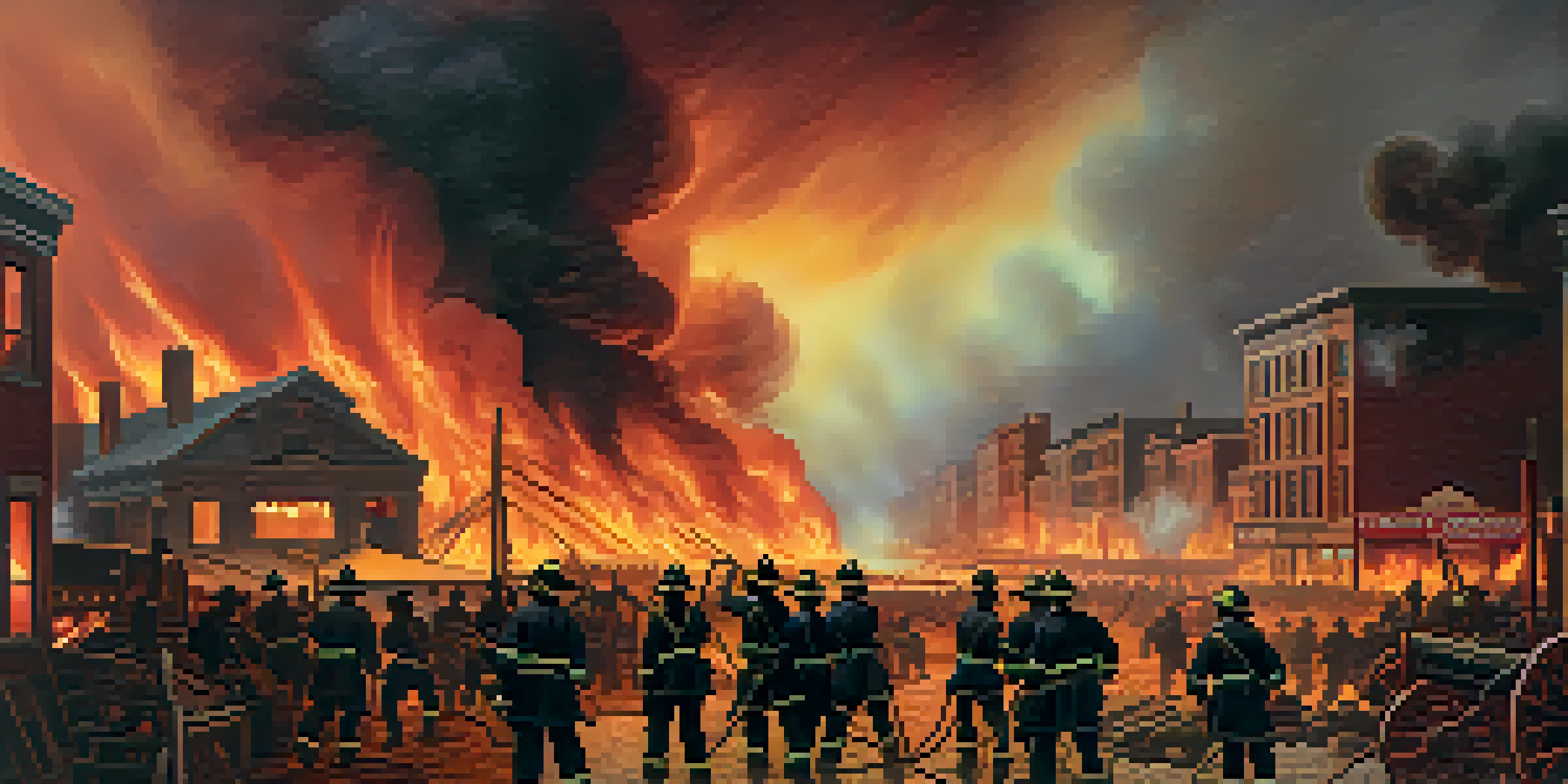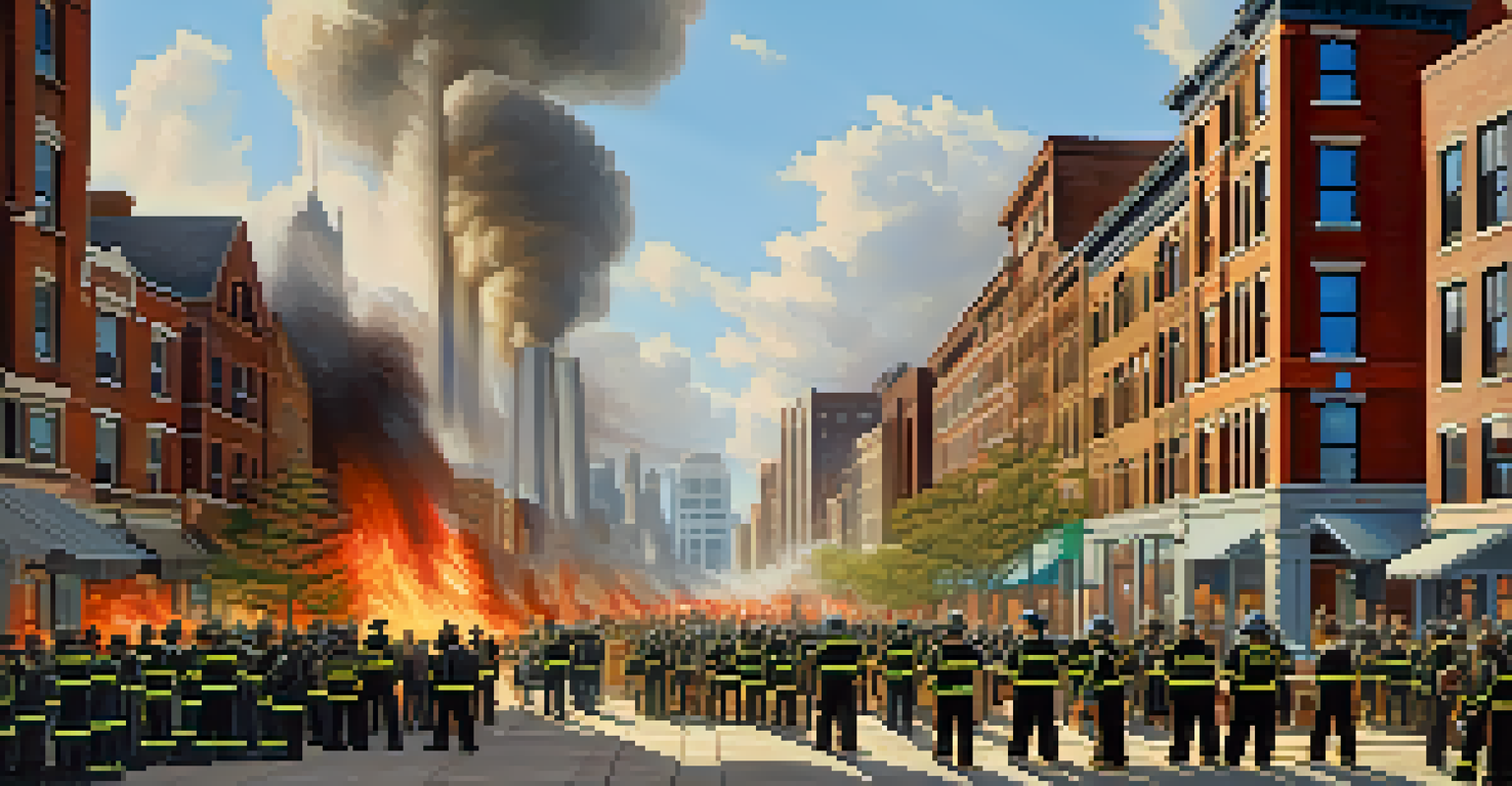The Great Chicago Fire: Causes and Consequences

A Brief Overview of the Great Chicago Fire
The Great Chicago Fire of 1871 was a devastating event that changed the city forever. Spanning from October 8 to October 10, this catastrophic blaze destroyed much of Chicago, leaving thousands homeless. The fire is often remembered for its ferocity and the sheer scale of destruction it caused, but understanding its background is critical.
The only thing we have to fear is fear itself.
Chicago was experiencing rapid growth in the years leading up to the fire, with wooden buildings dominating the urban landscape. This made the city particularly vulnerable to fire, as these structures were not only flammable but also close together. The combination of dry weather and strong winds would ultimately create a perfect storm for disaster.
The fire claimed the lives of approximately 300 people and left around 100,000 residents without homes. It serves as a poignant reminder of the importance of urban planning and fire safety in city development.
Key Causes of the Great Chicago Fire
Several factors contributed to the outbreak of the Great Chicago Fire, with one popular myth pointing to a cow kicking over a lantern. While this story captures the imagination, the reality is more complex. The city’s dry conditions, along with wood-based construction, created a precarious situation that was ripe for disaster.

A prolonged drought in the summer of 1871 had left the landscape parched, making it easy for flames to spread rapidly. Additionally, the lack of adequate fire regulations and firefighting resources exacerbated the situation. Many fire hydrants were out of order, and the fire department was overwhelmed by the sheer scale of the inferno.
Devastation Redefined Chicago
The Great Chicago Fire of 1871 destroyed approximately 17,500 structures and left around 100,000 residents homeless, highlighting the need for better urban planning.
Another contributing factor was the presence of highly flammable materials, such as sawdust and coal, which were common in the industrial areas of Chicago. This perfect storm of conditions ultimately allowed the fire to escalate uncontrollably, leading to widespread devastation.
The Role of Weather in the Fire's Spread
Weather conditions played a pivotal role in the rapid spread of the fire. A strong southwest wind fanned the flames, allowing them to leap from building to building with alarming speed. This wind not only carried embers far from the initial fire but also created chaotic conditions for firefighting efforts.
In the midst of chaos, there is also opportunity.
As the fire raged, the atmosphere became charged with heat, creating its own weather patterns. In some areas, the air became so hot that it created whirlwinds of fire, further complicating attempts to contain the blaze. Firefighters struggled against the elements, often finding themselves at the mercy of the wind.
The combination of high temperatures and wind transformed the fire into a raging inferno, leading to the destruction of entire city blocks in mere minutes. This illustrates how weather can dramatically influence the outcome of human events, especially in urban environments.
The Immediate Consequences of the Fire
In the aftermath of the Great Chicago Fire, the immediate consequences were overwhelming. The city was left in ruins, with approximately 17,500 structures destroyed. As a result, thousands of residents were displaced, and a sense of chaos and desperation filled the air.
Emergency shelters sprang up almost overnight, as the community rallied to assist those who had lost everything. Local organizations, churches, and residents worked tirelessly to provide food, clothing, and shelter to those affected by the disaster. This collective effort demonstrated the resilience and solidarity of the Chicago community during a time of crisis.
Impact of Weather on Fire Spread
Strong winds and dry conditions played a crucial role in the rapid spread of the fire, illustrating how weather can dramatically influence urban disasters.
However, with so many people now homeless, the city faced a significant humanitarian challenge. The loss of life and property was staggering, leading to a demand for rebuilding efforts that would shape Chicago's future.
Long-term Effects on Urban Planning and Fire Safety
The Great Chicago Fire prompted significant changes in urban planning and fire safety regulations. In the wake of the disaster, city planners recognized the importance of fire-resistant materials and better building codes. This shift was crucial in preventing future tragedies and laid the groundwork for modern city planning.
Chicago's rebuilding efforts showcased a new vision for the city, with a focus on wider streets and the use of brick and stone in construction. These changes helped to create a safer urban environment, ensuring that buildings were less susceptible to fire hazards. The lessons learned from the fire influenced building practices across the country.
Moreover, the incident led to the establishment of more organized firefighting services and improved emergency response protocols. The fire served as a wake-up call for many cities, leading to nationwide reforms in fire safety that are still relevant today.
Cultural Impact and Historical Legacy
The Great Chicago Fire left an indelible mark on American culture and history. It inspired countless stories, songs, and artworks, capturing the imagination of generations to come. The event is often referenced in literature and has become a symbol of resilience in the face of adversity.
In addition to cultural references, the fire also established Chicago as a city of innovation and rebirth. The rebuilding process attracted architects and visionaries who would go on to shape the city's iconic skyline. This period of transformation is often viewed as a turning point in Chicago's history, marking its emergence as a major urban center.
Lessons for Future Urban Safety
The aftermath of the fire led to significant changes in fire safety regulations and urban planning, emphasizing the importance of community resilience and preparedness.
Today, annual events and memorials commemorate the fire, ensuring that its lessons and legacy are never forgotten. The Great Chicago Fire serves as a reminder of the power of nature and the human spirit's ability to rebuild and move forward.
Lessons Learned from the Great Chicago Fire
The Great Chicago Fire teaches us important lessons about preparedness and community resilience. One key takeaway is the necessity of having effective fire safety measures in place, especially in densely populated urban areas. This includes regular maintenance of fire hydrants and the establishment of clear emergency response plans.
Furthermore, the incident underscores the importance of community support systems during disasters. The way Chicagoans came together to help each other in the wake of the fire is a testament to the strength of community bonds. It highlights the value of having a network of support in times of crisis.

Finally, the fire serves as a reminder of the ever-present risk of natural disasters, urging cities to prioritize sustainable and fire-resistant infrastructure. By learning from the past, we can create safer environments for future generations.